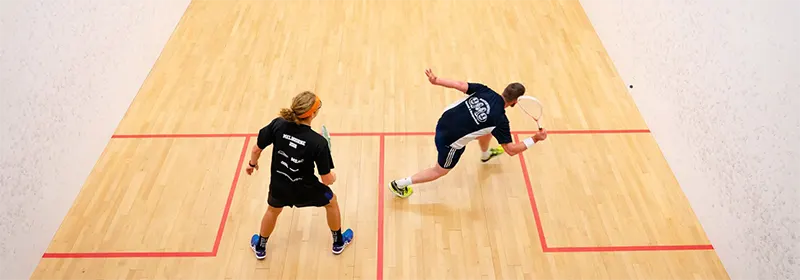13 July 2022 / 3-Min Read / Translate
The first thing I should explain though is what is a boast. A boast is a shot that has been purposefully hit against one of the side walls first. Its general objective is to place the ball at the front of the court, and move the opponent forward, but not always. Boasts can be both attacking and defending shots. I used the word “purposefully” just now because if you hit a straight shot that accidentally hits the side wall first instead of the front wall, that’s not a boast, that’s just a bad straight drive!
A working boast is a shot played from between the service box and back corner. A boast is generally an attacking shot and should be played when the striker is well-balanced and able to reach any return shot their opponent would make. It hits the side wall near the service box, about a racket’s height from the floor and should hit the front wall near the middle of the court’s width, about a racket’s head above the tin. The ball then takes its first bounce on the floor, followed by the most important bounce; the second bounce, near the floor and the opposite side wall.

Looks like the previous shot was a boast.
To answer that question, let’s look at things from your opponent’s perspective. Ideally, they would like to hit the ball straight most often. They want to do this because you are on the other side of the court, so that’s the maximum amount of movement for you. I’m not saying you can’t hit crosscourt if your opponent hits a boast, I’m saying the best percentage shot is probably a straight shot.
To hit a really good straight shot, you want the contact point to be near the side wall. But if the point when it is closest to the side wall is when it is amount to hit the nick, that really makes the decision hard for your opponent. Do they hit it before the sidewall or after? Remember, they have a split-second to make that decision.
A working boast doesn’t have to be hit hard, in fact, most working boasts aren’t. Oh, I should mention that another name for a working boast is a two-wall boast. That name describes its physical description, whereas “working boast” better describes its function: to work the opponent. You are trying to make your opponent hit a weak return from your two-wall boast. Yes, sometimes it’s s winner because your opponent didn’t read the shot and other times because they waited too long and then it hit the nick. But most times the shot is retrieved. So don’t play these boasts expecting winners.
The boast and drive pair drill is perfect for practicing your working boasts. Both players get an opportunity to improve the aspect of the game that is covered by this drill. The key to ensuring you get the maximum out of the drill is to get back to the T, which by the way is not the same place for both players.
I suggest you swap places every 1 minute or so. That might seem like not very long, but if you really are getting back to the T from the front, 1 minute will seem like a long time. You can do a few sets of each position, then take a drink break. As you get better at the drill add other shots to the drill. Fo example, a drop for the person at the front or a straight drive for the person at the back. Then you can add competitive elements into the drill.
A working boast moves your opponent around the court and if played well will limited their options.